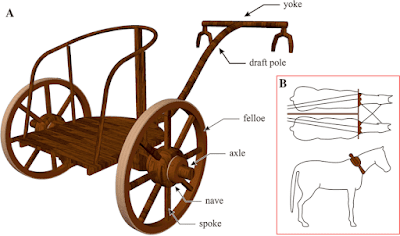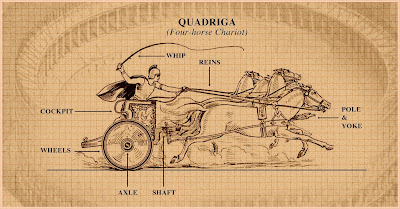§44 NOVUM PROELIUM
In proeliīs Britannī esseda habent. Magnae sunt rotae
essedōrum. Rotae essedōrum nostrōs vulnerant. Sonus rotārum equōs Rōmānōrum
perturbat. Essedum duās rotās et duōs equōs habet. Auriga in essedō est.
Britannī esseda armātīs complent. Armātī 'essedariī' vocantur. Essedāriī longās
hastās habent. In essedō nōn manent. In
proeliō pugnant. Ecce! essedum in campō est. In essedō quīnque essedāriī sunt.
Aurīga equōs incitat. Aurīga in iugō stat. Ecce! essedāriī in essedō nōn
manent. Nunc in proeliō pugnant.
Crassus essedāriōs videt. Magnum pīlum habet Crassus. Ūnus
ex essedāriīs magnus est. Magnus essedārius Segovax vocātur. Crassus barbarum
videt, sed barbarus Crassum nōn terret. Barbarōs Rōmānum nōn saepe fugat.
Crassus nostrōs incitat. Ecce! barbarum vulnerat. Segovax mortuus est. Rōmānī
reliquōs essedariōs fugant. Reliquī essedariī nunc in essedō sunt. Aurīga equōs
incitat. Rōmānī essedāriōs barbarōrum fugant. Quattuor modo essedāriī in essedō
sunt. Nam Segovax mortuus est. Quam impavidī sunt Rōmānī, quam impavidus est
Crassus!
Vocabulary
iugum, -ī [2/n]: yoke
rota, -ae [1/f]: wheel
sonus, -ī [2/m]: sound
The author makes a distinction in this text between:
[i] aurīga, -ae [1/m]: charioteer, the man who drives the
chariot and spurs on the horses
[ii] essedārius, -ī [1/m]: soldiers on the chariot who fight
in the battle
Notes
[1]
vocat: he / she calls > vocātur: he / she is
called
vocant: they call > vocantur: they are called
These are examples of the passive form of the verb.
The grammatical term passive voice refers to when the subject of the sentence
isn’t performing the action, but is experiencing the action. In Latin, some
parts of the passive are easy to recognise: for the 3rd person
singular and plural present tense, -ur is added to the end of the verb.
[2]
Ūnus ex essedāriīs: literally “one out of
the charioteers” = one of the
charioteers
§45: interrogātiō
Below are the questions for this text in Latin and English.
Complete the questions with the words listed below each section. The full text
is given at the end, but try the exercise first.
Section #1
[1] What do the Britons have in battles? │ __________
in proeliīs habent Britannī?
[2] How many wheels does a chariot have? │ __________ rotās habet __________?
[3] Are the wheels of the chariots large?
│ __________ rotae __________ __________?
[4] How many horses does a chariot have? │ Quot equōs
__________ essedum?
[5] Quis in iugō stat? │ __________ stands at the
yoke?
[6] Where do the charioteers stand? │ __________
__________ essedāriī?
[7] Where does the chariot driver stand? │ Ubi __________ aurīga?
[8] How many charioteers are in the chariot? │ Quot __________
in essedō sunt?
[9] Why do the charioteers not stay in the chariot?
│ __________ essedariī in __________ nōn manent?
[10] Do the charioteers have weapons? │ __________ essedāriī arma?
cūr; essedariī; essedō; essedōrum; essedum; habentne; habet;
magnae; quid; quis; quot; stant; stat; sunte; ubi
Section #2
[11] Who sees the charioteers? │ Quis __________ videt?
[12] How many charioteers are large? │ Quot essedāriī
__________ sunt?
[13] Does Crassus see the large charioteer?
│ __________ Crassus __________ __________?
[14] Does the barbarian frighten Crassus? │ __________
barbarus Crassum?
[15] Who injures the barbarian? │ Quis barbarum __________?
[16] Who is dead? │ Quis mortuus __________?
[17] Where are the rest of the charioteers now? │ Ubi
nunc reliquī essedāriī __________?
[18] What does the chariot driver do? │ Quid __________
aurīga?
[19] Where is the chariot driver standing? │ Ubi stat
__________?
[20] How many charioteers are now in the chariot? │ Quot
essedārīī __________ in essedō sunt?
aurīga; essedariōs; essedārium; est; facit; magnī; magnum; nunc;
sunt; terretne; videtne; vulnerat




